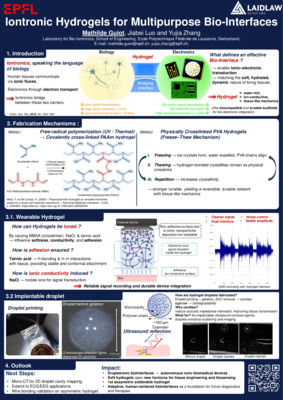Engineering Iontronic Hydrogels: Connecting Living Tissues and Electronic Systems
The Challenge
How do you make electronics talk to biology? Traditional bioelectronics use rigid materials that don't play well with soft tissues, think metal electrodes on skin or implants that cause inflammation. Iontronic hydrogels offer a solution: they're soft like tissue, conduct ions like biological systems, and can interface with electronics.
My project tackled this at two scales:
- Macroscale patches for wearable EMG sensors with a twist—one side sticks to skin, the other can be soldered to wires
- Microscale droplets (~100 μm) with tiny cavities inside that light up on ultrasound, helping doctors see exactly where implants are and enabling more precise treatments
The Reality of Research
Eight weeks in the Lab of Bio-Iontronic taught me more about persistence than perfection. Most experiments didn’t work the first, or the tenth time. Over 30 hydrogel formulations later, I learned to balance conductivity, flexibility, and adhesion through endless rounds of testing, adjusting, and starting over.
Dr. Jiabei Luo’s advice was simple: stop chasing the perfect plan and just test. Each attempt, successful or not, revealed something new, a pattern, a limit, a clue. Progress came from iteration, not certainty.
What Changed
I became comfortable with uncertainty, and started thinking across disciplines: chemistry, materials, electronics, biology, all converging in one project.
Research Outcomes
By the end of the summer, we achieved:
-
Asymmetric hydrogels with dual surfaces—adhesive and soft on one side, solderable and conductive on the other
-
Optimized formulations with tissue-like mechanics and strong EMG signal quality
-
Microscale droplets featuring internal cavities for enhanced ultrasound contrast and treatment
-
Comprehensive characterization validating potential for both wearable and implantable biointerfaces
But the real outcome wasn’t just the materials, it was learning how to do research: to fail productively, iterate fast, and find direction through experimentation.
Gratitude and Reflection
This project was made possible through the Laidlaw Foundation’s commitment to research and leadership. I am deeply grateful to Professor Zhang for welcoming me into the Laboratory of Bio Iontronic, to Dr. Luo for his patient mentorship and practical wisdom, and to Dan Thi for her guidance throughout the program.
To my fellow Laidlaw Scholars, it was a privilege to learn alongside such thoughtful and committed peers !
📎 Attachment:
- Full research report


Please sign in
If you are a registered user on Laidlaw Scholars Network, please sign in
Cool report Mathilde, I love all the figures, it makes your explanations very clear! Feeling more comfortable with uncertainty is also one important ability I’ve learned throughout my research internship! Congratulations for your work!